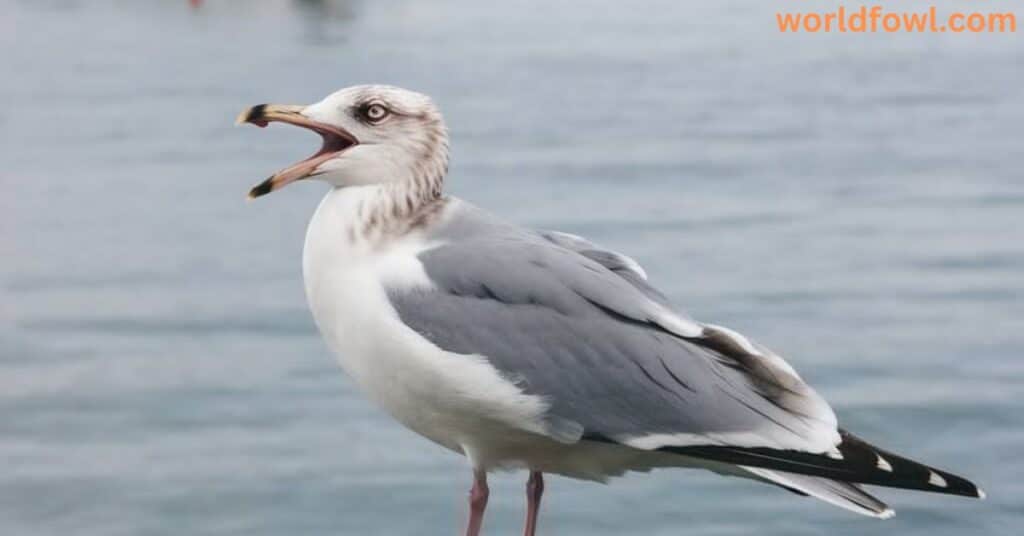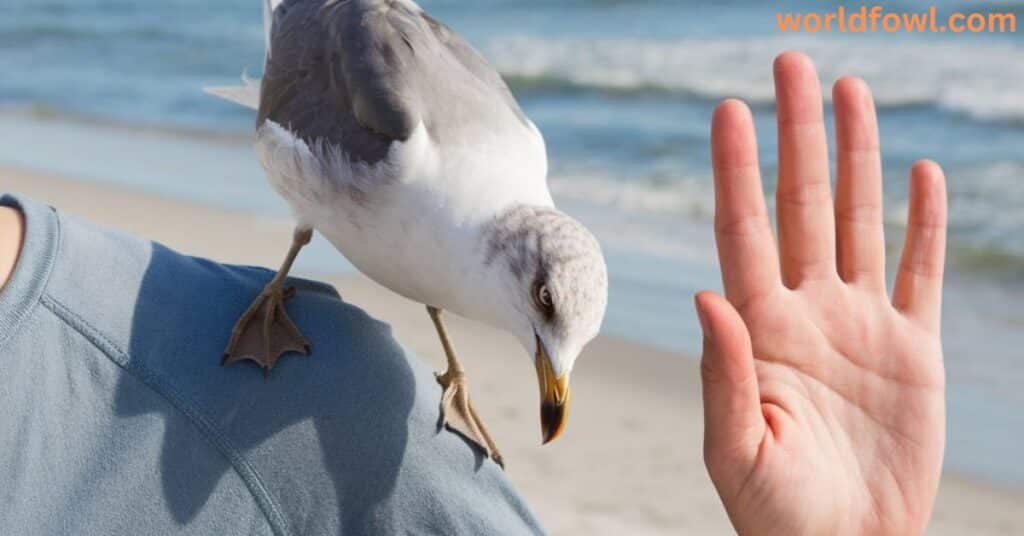When we think of seagulls, we often picture these coastal birds soaring gracefully through the sky, diving for fish, or scavenging near the beach. But, have you ever wondered, Do Seagulls Attack Humans? It might seem surprising, considering how commonplace these birds are, but it turns out that seagulls do indeed exhibit aggressive behavior—especially under certain conditions. This post will provide an in-depth exploration of the reasons behind seagull aggression, how dangerous these attacks can be, and most importantly, how you can avoid becoming the target of a seagull’s territorial swoop.
Whether you’re at the beach enjoying a snack or walking through an urban park, knowing the behaviors and triggers behind seagull attacks can help you stay safe and understand these fascinating birds a little better.
What Are Seagulls?

Before we delve into the reasons for seagull aggression, it’s important to understand what seagulls are, how they behave, and why they are so commonly found in human-dominated spaces.
Seagulls belong to the family Laridae, and are a part of the broader order of birds known as Charadriiformes. These coastal birds have adapted to life in close proximity to humans, making them a staple of both coastal and urban environments. Seagulls are highly opportunistic and have a versatile diet, which makes them successful at surviving in a variety of habitats.
Seagull Species
There are many species of seagulls, but some of the most common ones include:
- Herring Gull: One of the largest and most well-known species, often found in both coastal and urban areas.
- Ring-billed Gull: Recognizable by the black ring around its bill, this species is commonly found in cities and around garbage dumps.
- Lesser Black-backed Gull: A smaller, more aggressive species that can often be seen scavenging in both coastal and urban spaces.
Seagulls are well-adapted to living in cities and coastal areas. Their territoriality and aggressive bird behavior often stem from their desire to protect food sources and nests, which can occasionally lead to conflict with humans.
See Also : Do Hummingbirds Attack Humans? Unexpected Aggressors!
Why Do Seagulls Attack Humans?

At their core, seagulls are not inherently violent creatures. Their aggression usually linked to their survival instincts, particularly in relation to food scavenging, territoriality, and mating season. Let’s break down the primary causes of seagull attacks on humans.
Nesting and Territorial Behavior
One of the primary drivers of seagull aggression is their territorial instincts, especially when it comes to nesting behavior. Seagulls are extremely protective of their nests and young, and they will fiercely defend their territories from any perceived threat—whether it be another bird or a human. This defensive behavior is most common during the breeding season when seagulls are at their most vulnerable and focused on protecting their offspring.
Nesting Behavior in Seagulls:
- Roofs and Urban Spaces: In urban environments, seagulls often nest on rooftops, ledges, and other elevated spots that provide them with safety from ground-based predators. These nesting sites become critical to their survival.
- Aggression During Breeding Season: The mating season in seagulls typically runs from late spring to early summer, during which they are especially territorial. Both male and female seagulls involved in territorial defense, and any movement near their nests may see as an invasion.
- Defense Mechanisms: If a human unknowingly comes too close to a seagull’s nest, the bird will often resort to swooping or even dive-bombing the intruder. This behavior intended to drive the perceived threat away, and while it can be startling, it is rarely dangerous.
In short, when you find yourself near a seagull nest, you’re stepping into a territory that the birds will fight to protect. Their aggressive behavior is simply an effort to secure their young and maintain their territory.
Food Source Competition
Seagulls are opportunistic feeders, which means they will eat whatever is available to them. This includes human food, scraps left on the beach, or food waste in urban areas. Food scavenging is one of the primary reasons why seagulls interact with humans so frequently, and it’s also a major cause of seagull attacks.
In places like beachside picnic areas, parks, and open-air cafes, seagulls often approach humans in search of an easy meal. If a gull feels that its food source is under threat—perhaps if someone is eating or holding onto something they want—it may become aggressive. Similarly, if a seagull sees you drop a piece of food, it may swoop in to grab it before you can even react.
How Food Scavenging Leads to Aggression:
- Attracting Gulls with Food: When humans eat in public spaces without securing their food, it can attract seagulls who used to finding easy sources of food.
- Aggression for Resources: During times of food scarcity or high competition for resources, seagulls may become more aggressive toward humans in an attempt to secure food.
- Urban Wildlife Conflicts: In urban environments, food waste is abundant. Seagulls have adapted to taking advantage of this, often resulting in more frequent interactions with humans, and more chances for aggressive behavior.
Mating Season Aggression
As mentioned earlier, the breeding season plays a major role in seagull attacks. During this time, hormonal changes make seagulls more territorial and defensive. Their aggression is especially high as they protect nests and chicks from potential threats. This heightened aggression usually see during late spring to early summer, particularly in areas where rooftop nesting is common.
During the mating season, even the most harmless interaction with a seagull misconstrued as a threat, leading to aggression. Seagulls may swoop, dive, or even attempt to peck at humans to keep them away from their nesting areas.
Provocation by Humans
Sometimes, seagulls attack simply because they feel provoked. While these birds are naturally wary of humans, certain actions can increase the likelihood of an attack. For example, direct eye contact with a seagull can be perceived as a challenge, causing the bird to become defensive. Additionally, aggressive movements—whether you’re swatting at the bird or trying to chase it away—can further escalate the situation.
Common Provocations:
- Getting Too Close to Nests: Even unintentionally, coming too close to a seagull nest can provoke an attack.
- Feeding Seagulls: Though it may seem harmless, feeding seagulls encourages them to associate humans with food, which increases the likelihood of aggression.
- Sudden Movements: Quick movements or attempts to shoo a seagull away may trigger a defensive response.
How Seagulls Interact with Humans
Understanding seagull aggression requires recognizing how seagulls generally perceive humans. Seagulls are opportunists and have learned to coexist with humans in many ways. Human-wildlife coexistence has become increasingly common, especially in urban spaces, but it is not always peaceful. Seagulls are highly intelligent, and they will respond to situations based on their needs—whether it’s protecting food or defending their territory.
See Also : Why Do Bees Attack Humans?
Are Seagull Attacks Dangerous?

While seagull attacks on humans are rarely life-threatening, they can still pose risks, both physically and in terms of health. The nature of seagull attacks can vary, from a simple swoop to a more direct pecking. But what about the potential for injury or harm? Let’s break down the risks.
Nature of the Attacks
Seagull attacks are typically defensive rather than predatory. In other words, the bird is not trying to hunt or hurt you—it’s simply trying to protect its territory or food.
- Swooping and Dive-bombing: These are the most common forms of attack. Seagulls will fly low and swoop down at a person’s head or body to drive them away.
- Pecking and Scratching: Seagulls may peck or scratch if they feel threatened or cornered. This type of attack is more likely to occur if a human is directly in the bird’s path or near a nest.
While these attacks are often harmless, they can cause scratches or bruises, particularly on the face or arms.
Potential Risks of Seagull Attacks
While the physical risks are generally minor, the greater concern lies in the disease transmission. Seagulls, like many birds, can carry pathogens that can be harmful to humans. The most notable of these are salmonella and avian flu.
- Salmonella Risks: Seagulls, especially those that frequent urban areas, may carry salmonella in their droppings, which can lead to food poisoning if humans come into contact with contaminated surfaces.
- Avian Flu: Though rare, avian flu transmitted through direct contact with birds or their droppings, posing a significant risk to human health, especially in large populations of birds.
In short, seagull attacks might cause more harm through potential disease transmission than through the physical injury itself. { Do Seagulls Attack Humans }
See Also : Do Sea Lions Attack Humans? Terrifying Tales!
How to Avoid Seagull Attacks

Avoiding a seagull attack is largely about understanding seagull behavior and taking proactive steps to prevent confrontations. Here’s what you can do to protect yourself:
Stay Away from Nests
One of the best ways to prevent a seagull attack is to avoid areas where the birds are nesting. Seagulls territorial during the breeding season, and any encroachment on their territory will be seen as a threat. If you come across a seagull nest, keep your distance.
How to Spot Seagull Nests:
- Look for seagulls acting unusually aggressive or protective when you approach a certain area.
- Seagull nests are often on rooftops or near cliff edges in urban environments.
Do Not Feed Seagulls
Feeding seagulls encourages them to associate humans with food, which leads to more aggressive bird behavior. By not feeding them, you can reduce the likelihood of attracting them to your location and lessen the chance of an attack.
Protect Your Food
If you’re eating in an area where seagulls are common, make sure to keep your food covered or indoors. Seagulls are highly adept at food scavenging and will often swoop in for a quick bite if they see food left unattended.
Remain Calm
If you do find yourself in a situation where a seagull is approaching or swooping toward you, the best response is to remain calm. Sudden movements can escalate the situation. Instead, back away slowly and avoid direct eye contact, which see as a challenge.
FAQs: Do Seagulls Attack Humans
Can Seagulls Carry Diseases to Humans?
Yes, seagulls can carry diseases like avian flu and salmonella, especially through their droppings. Always wash your hands after interacting with seagulls or cleaning up after them to reduce the risk of disease transmission.
What Should I Do if a Seagull Attacks Me?
If a seagull attacks, the first thing to do is to remain calm. Move away slowly, and avoid eye contact, which perceived as a challenge. If injured, clean the wound with antiseptic and seek medical advice if needed.
Are Seagulls Protected by Law?
In many countries, seagulls protected under bird protection laws. These laws vary, but in general, disturbing or harming seagulls and their nests is illegal in some regions. Always check local regulations before interacting with seagulls in protected areas.
Do Seagulls Attack Pets?
Seagulls can sometimes be aggressive toward small pets, especially if they feel their territory or food is being threatened. It’s important to keep pets away from areas where seagulls are nesting or scavenging.
Why Are Seagulls More Aggressive in Cities?
Urban environments provide seagulls with an abundance of food and few natural predators, which makes them more likely to engage with humans. Territorial instincts and food scavenging behaviors are often more pronounced in cities, where food waste is prevalent.
Conclusion: Do Seagulls Attack Humans?
While seagull attacks on humans can be alarming, they are typically driven by natural instincts related to territoriality, food scavenging, and mating season aggression. These birds are simply acting in the way that they know best to protect their nests, food sources, and young.
Understanding seagull behavior and taking steps to avoid conflict can ensure that you remain safe while coexisting with these coastal birds. So, the next time you encounter a seagull, remember: they’re just trying to survive in a world where food is scarce and territories are fiercely defended.
By respecting their space and being mindful of your surroundings, you can enjoy the beauty of these birds without worrying about an unexpected swoop! { Do Seagulls Attack Humans }

Henry James is a seasoned blogger and a passionate storyteller on “World Fowl.” With years of experience crafting engaging content, he brings a unique blend of expertise and creativity to his writing. Henry specializes in exploring diverse topics with depth and clarity, captivating readers worldwide.







